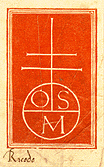
1484, Venice: OTTAVIANO SCOTO
Although without illustrations, this book is considered one of the most
beautiful of the 15th-century imprints from a typographical perspective.
It is characterized by very consistent inking and press work, resulting
in clean, full letters. It is also distinguished by good quality leading,
or spacing, and exact imposition, that is, the alignment of the text block
and headline with previous and later pages. Finally, one notes elegant capital
blocks throughout.
This is the first reissuing of the Landino commentary which assumed the
status of a vulgate during the 15th century. It is nonetheless noteworthy
for the care which was taken in its preparation: while some omissions from
the text are the same as those of 1481, other passages which were missing
from 1481 are restored. Generally speaking, the text reveals the intervention
of correctors who aspired to some measure of orthographic regularity and
textual quality.
This copy is also remarkable for the original binding, and for its completeness:
the last page bearing the printer's mark is extremely rare among extant
copies. The majority of books during the incunable period were sold unbound.
Professional bookbinders had been practicing their art on manuscripts for
several hundred years and could produce elegant leather or vellum bindings
with custom designed tool work and clasps as the customer desired.
Ottaviano Scoto headed a distinguished family of Venetian printers. Born
of a noble family of Monza, he came to Venice at the age of 35 and operated
a press there between 1479 and 1484. He continued as an editor until 1499
whereupon his heirs, including his brothers and nephews, undertook their
own activity (1499-1532). The original printer's mark of Ottaviano Scoto,
displayed here, was an elegant circle from whose center extended a double
cross. Within the circle are the letters O.S.M, the initials of Octavianus
Scotus Modoetiensis (Ottaviano Scoto of Monza).

